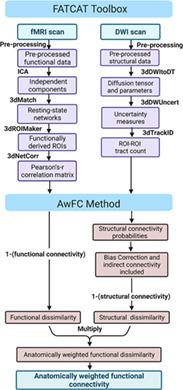当前位置:
X-MOL 学术
›
Hum. Brain Mapp.
›
论文详情
Our official English website, www.x-mol.net, welcomes your
feedback! (Note: you will need to create a separate account there.)
Exploring brain connectivity changes in major depressive disorder using functional-structural data fusion: A CAN-BIND-1 study
Human Brain Mapping ( IF 3.5 ) Pub Date : 2021-07-23 , DOI: 10.1002/hbm.25590 Sondos Ayyash 1, 2 , Andrew D Davis 3, 4 , Gésine L Alders 5 , Glenda MacQueen 6, 7 , Stephen C Strother 4, 8, 9 , Stefanie Hassel 6, 7 , Mojdeh Zamyadi 4 , Stephen R Arnott 4 , Jacqueline K Harris 10 , Raymond W Lam 11 , Roumen Milev 12 , Daniel J Müller 13, 14 , Sidney H Kennedy 8, 14, 15, 16, 17 , Susan Rotzinger 14, 16, 17 , Benicio N Frey 3, 5, 18 , Luciano Minuzzi 3, 5, 18 , Geoffrey B Hall 1, 2, 3, 5 ,
Human Brain Mapping ( IF 3.5 ) Pub Date : 2021-07-23 , DOI: 10.1002/hbm.25590 Sondos Ayyash 1, 2 , Andrew D Davis 3, 4 , Gésine L Alders 5 , Glenda MacQueen 6, 7 , Stephen C Strother 4, 8, 9 , Stefanie Hassel 6, 7 , Mojdeh Zamyadi 4 , Stephen R Arnott 4 , Jacqueline K Harris 10 , Raymond W Lam 11 , Roumen Milev 12 , Daniel J Müller 13, 14 , Sidney H Kennedy 8, 14, 15, 16, 17 , Susan Rotzinger 14, 16, 17 , Benicio N Frey 3, 5, 18 , Luciano Minuzzi 3, 5, 18 , Geoffrey B Hall 1, 2, 3, 5 ,
Affiliation

|
There is a growing interest in examining the wealth of data generated by fusing functional and structural imaging information sources. These approaches may have clinical utility in identifying disruptions in the brain networks that underlie major depressive disorder (MDD). We combined an existing software toolbox with a mathematically dense statistical method to produce a novel processing pipeline for the fast and easy implementation of data fusion analysis (FATCAT-awFC). The novel FATCAT-awFC pipeline was then utilized to identify connectivity (conventional functional, conventional structural and anatomically weighted functional connectivy) changes in MDD patients compared to healthy comparison participants (HC). Data were acquired from the Canadian Biomarker Integration Network for Depression (CAN-BIND-1) study. Large-scale resting-state networks were assessed. We found statistically significant anatomically-weighted functional connectivity (awFC) group differences in the default mode network and the ventral attention network, with a modest effect size (d < 0.4). Functional and structural connectivity seemed to overlap in significance between one region-pair within the default mode network. By combining structural and functional data, awFC served to heighten or reduce the magnitude of connectivity differences in various regions distinguishing MDD from HC. This method can help us more fully understand the interconnected nature of structural and functional connectivity as it relates to depression.
中文翻译:

使用功能结构数据融合探索重度抑郁症的大脑连接变化:一项 CAN-BIND-1 研究
人们越来越关注通过融合功能和结构成像信息源生成的大量数据。这些方法可能在识别作为重度抑郁症 (MDD) 基础的大脑网络中断方面具有临床实用性。我们将现有的软件工具箱与数学密集的统计方法相结合,生成了一种新颖的处理管道,用于快速轻松地实施数据融合分析 ( FATCAT-awFC )。新的FATCAT-awFC然后使用管道来识别 MDD 患者与健康比较参与者 (HC) 相比的连接性(常规功能、常规结构和解剖加权功能连接)变化。数据来自加拿大抑郁症生物标志物整合网络 (CAN-BIND-1) 研究。评估了大规模的静息状态网络。我们发现默认模式网络和腹侧注意网络中具有统计学意义的解剖加权功能连接 (awFC) 组差异,具有适度的效应大小 ( d < 0.4)。默认模式网络中的一个区域对之间的功能和结构连接似乎在重要性上重叠。通过结合结构和功能数据,awFC 有助于提高或减少将 MDD 与 HC 区分开来的各个区域的连通性差异。这种方法可以帮助我们更全面地了解结构和功能连接的相互关联性,因为它与抑郁症有关。
更新日期:2021-09-19
中文翻译:

使用功能结构数据融合探索重度抑郁症的大脑连接变化:一项 CAN-BIND-1 研究
人们越来越关注通过融合功能和结构成像信息源生成的大量数据。这些方法可能在识别作为重度抑郁症 (MDD) 基础的大脑网络中断方面具有临床实用性。我们将现有的软件工具箱与数学密集的统计方法相结合,生成了一种新颖的处理管道,用于快速轻松地实施数据融合分析 ( FATCAT-awFC )。新的FATCAT-awFC然后使用管道来识别 MDD 患者与健康比较参与者 (HC) 相比的连接性(常规功能、常规结构和解剖加权功能连接)变化。数据来自加拿大抑郁症生物标志物整合网络 (CAN-BIND-1) 研究。评估了大规模的静息状态网络。我们发现默认模式网络和腹侧注意网络中具有统计学意义的解剖加权功能连接 (awFC) 组差异,具有适度的效应大小 ( d < 0.4)。默认模式网络中的一个区域对之间的功能和结构连接似乎在重要性上重叠。通过结合结构和功能数据,awFC 有助于提高或减少将 MDD 与 HC 区分开来的各个区域的连通性差异。这种方法可以帮助我们更全面地了解结构和功能连接的相互关联性,因为它与抑郁症有关。











































 京公网安备 11010802027423号
京公网安备 11010802027423号